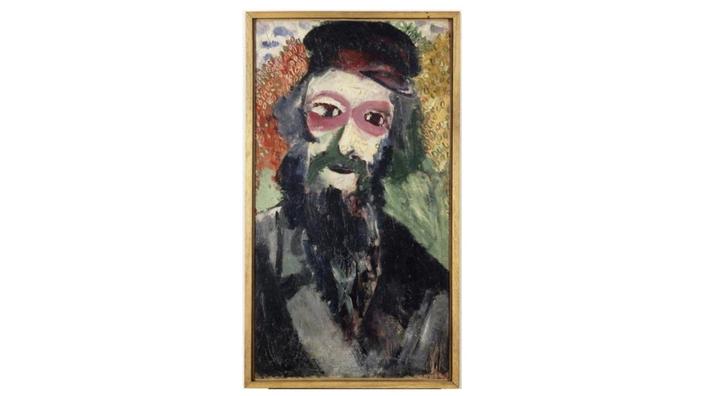Visitors to the Museum of Art and History of Judaism in Paris could admire a painting by Chagall, depicting his father.
In a few months, the portrait will leave the walls of this national museum to be returned to the descendants of a certain David Cender.
The trajectory of the work, extravagant, is like the fragmented fate, and fortunately full of twists, of Jewish spoliation.
Marc Chagall, living in Paris in La Ruche, a city of artists, painted this picture in 1911;
the painter then left France in 1914, the year the conflict began, which forced him to stay away from France, and therefore from his studio, until 1922. In the meantime, his paintings disappeared, probably stolen.
The Father
is one of these disappearances.
Read also Restitution of looted property: a new course for France
Without anyone knowing how, the painting then arrived in Poland, and was put up for sale by an art dealer in Warsaw, Abe Gutnajer.
In 1928, David Cender, Polish musician and luthier, bought it.
But in the spring of 1940, the life of the luthier, who is Jewish and lives in Lodz, changes.
He and his family are forced to settle in the ghetto, abandoning all their possessions – including the Chagall.
In August 1944, when the ghetto was "liquidated", David Cender was still alive, unlike his wife and daughter.
Ill, he ended up emigrating in 1958 to France, the country where his sister lived.
An incredible trajectory
This is the time when the Federal Republic of Germany launched compensation procedures (Brug law) for the Jews. Like many of his co-religionists, David Cender reported the theft of several works of art, including the painting by Chagall, which he titled
Old Jewish Man or Jew Ordering Prayer
. He describes the work very precisely, produces testimonies, including that of a doctor in Lodz and collector, survivor of the ghettos of Lodz and Warsaw, emigrated to France after the war. The investigation takes years, and David Cender dies seven years before Germany admits to recognizing his property as well as the spoliation of which he has been the victim. We don't know where the painting is,and we will have to wait until 2020 to learn its incredible trajectory, to say the least.
"After the war, Le Père was on the market again and Chagall, who was attached to it for sentimental reasons, bought it back, probably between 1947 and 1953,"
explains David Zivie, head of the mission of research and restitution of cultural property looted between 1933 and 1945.
“The artist obviously has no information allowing him to know that the painting was looted”.
After his death, the heirs of Marc Chagall will give to the French State, through a donation, 46 paintings, 150 gouaches and 229 drawings.
The portrait is part of this fabulous set and is deposited in the Museum of Judaism.
Things were there, until a phone call from the lawyer representing the grand-nephews of David Cender, his heirs, in 2020.
“We have received an official request for restitution. Although this affair is complex, the government has decided, after a number of verifications made by the Ministry of Culture, to respond to it favourably”
continues David Zivie.
Consulted, the Chagall Committee, which promotes and defends his work, said it was in full agreement with this restitution, despite the initial disappearance of the contents of the artist's studio.
An exceptional law
Officially, the painting still belongs to the French state. It must therefore be removed from national collections to be returned. Tuesday, January 25, the National Assembly will precisely consider an exceptional law, allowing to derogate from the sacrosanct principle of ineliability of national collections, in the name of the repair of Jewish spoliations. The text was originally built to allow
Rosebushes to come out under the trees
by Gustav Klimt, acquired by the Musée d'Orsay in 1980, and which was discovered to belong to an Austrian woman, despoiled before being deported, eleven drawings and a waxwork conserved at the Louvre Museum, the Museum of Orsay and at the Musée du Château de Compiègne, bought by the director of French museums during a sale in Nice in 1942, but belonging to a Jewish collector, Armand Dorville, as well as a painting by Utrillo kept at the Musée Utrillo-Valadon , “Crossroads in Sannois”).
The Chagall affair, which happened when the bill was already drafted, was the subject of a government amendment, adopted unanimously by the Cultural Affairs Committee.
Will it be necessary, one day, to pass through a framework law on Jewish restitutions, allowing the State to “downgrade” national collections, as much as necessary?
While several other restitutions are being examined, Roselyne Bachelot, for whom the word repair is not an empty word, has answered this question decisively.
This time,
"we had to move quickly, and implement these restitutions, some of which - this is the case of the Sannois painting - had been pending for several years, but I am in favor of the adoption of a law allowing the creation of a mechanism for the restitution of works looted in the context of anti-Semitic persecution between 1933 and 1945”
she asserted.
The hell is in the details, and this law will be complicated to write, if we don't want to create a resistance movement in museums.
But recent history has shown that without political will, the descendants of despoiled Jews often come up against a wall of refusal.
And it is this that Roselyne Bachelot wishes to tackle, stone by stone, if the results of the next presidential election are favorable to her.

